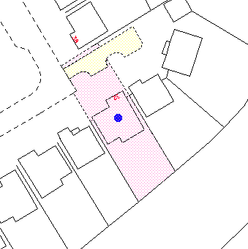Mapping Common Areas and Shared Plots
Pertinents
Shared plots should be distinguished from pertinents of the property, such as common paths, mutual driveways, shared gardens and back courtyards or communal bin stores. The decision as to whether or not something is a pertinent will depend on the circumstances of each case. By way of general guidance however if an area of ground is intrinsic to the use and enjoyment of the primary plot, such as a shared path or common driveway, or in some way performs a function that enhances the use of the same, such as a bin or cycle store, then the same is likely to be considered a pertinent of such property. These examples are not exclusive and if in doubt registration officers should seek further guidance from their referral point.
If the common area is to be mapped as a pertinent then provide a reference for it on the cadastral unit for the primary plot. In practical terms the procedure will be almost identical to that set out under Map the Title - FR Plans - RA - Common Areas, Transitional Provisions and Add LRS Information - FR Plans - RA - common areas, transitional provisions and those pages may be referred to for guidance if required.
Where under previous guidance one or more shares in an area which would otherwise be considered to be a pertinent of a primary plot, such as where the owners of four houses in a small terrace each own a 1/4 pro indiviso share in a common drying green at the rear of the properties, have been included in a shared plot title sheet, then all subsequent shares in that area should be registered in a similar manner.
For the avoidance of doubt where, for example, a Deed of Conditions defines the common amenity area of the development in which all the properties have a pro indiviso share as including smaller areas, such as bin stores or parking spaces which would otherwise be considered pertinents of the individual primary plots, then no attempt should be made to subdivide the common amenity area when creating the shared plot title sheet pertaining thereto.
Shared Plots or Transitional Provisions
Section 17 of the 2012 Act allows the Keeper to create a shared plot title sheet when a plot of land
- is owned in common by the proprietors of two or more other plots of land by virtue of their ownership of those other plots, and
- is not owned in common by anyone else.
In other words, if the owners of the forty houses in a development each own a 1/40 pro indiviso share in a common amenity area, the Keeper can set up a shared plot title sheet for the common amenity area when the first house is submitted for first registration in the land register as the amenity area is owned in common by virtue of the ownership of the houses - see Further Guidance on FR - When to Create or Add to a Shared Plot Title Sheet or TP - When to Create or Add to a Shared Plot Title Sheet. However, if shares in that amenity area have already been registered in the land register under the terms and practices of the 1979 Act (or using the 2012 Act transitional provisions) it is not appropriate for the Keeper to create a shared plot title sheet when a further share in that common area is submitted for registration under the 2012 Act. Instead, the rights to the common areas should be registered under the transitional provisions - see Further Guidance on FR - When to Map Common Areas Under the Transitional Provisions or TP - When to Map Common Areas Under the Transitional Provisions.
Section 17 also applies in tenement, flatted or other sub-divided properties, but only to those plots of land owned in common that fall outwith the extent of the tenement steading. Any areas within the extent of the tenement steading that are owned in common by the flats in that tenement are covered by the provisions in section 16 of the 2012 Act, and do not require shared plots to be created or transitional provisions to be followed - see Further Guidance on Mapping Tenement Properties.
What are shared and sharing plot title sheets?
When Section 17 does not apply
If two individuals each purchase a 50% share in (for example) a field, the Keeper will not set up a shared plot title sheet when the first share is submitted for first registration in the land register. This is because the field is being purchased as a discrete area of ground and is not related to the ownership of any other area of ground or building. Instead, an ordinary title sheet will be set up for the field cadastral unit and the proprietorship section of the title sheet would reflect the owners and their respective shares in it.
Registers of Scotland (RoS) seeks to ensure that the information published in the 2012 Act Registration Manual is up to date and accurate but it may be amended from time to time.
The Manual is an internal document intended for RoS staff only. The information in the Manual does not constitute legal or professional advice and RoS cannot accept any liability for actions arising from its use.
Using this website requires you to accept cookies. More information on cookies.
Feedback

.png?version=1&modificationDate=1547817795209&cacheVersion=1&api=v2)